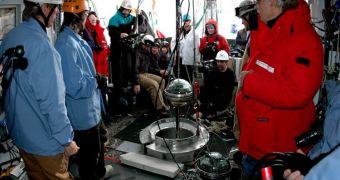An in-depth survey of the sky, conducted using a massive, underground particle detector at the South Pole, has revealed that the production of cosmic rays is a more mysterious phenomenon than experts had first predicted. The theories currently trying to explain where these rays originate may all be wrong.
The new study was conducted using the IceCube Neutrino Observatory, which is located underneath the US Amundsen-Scott South Pole Station, in Antarctica, at the world's geographic South Pole.
The massive detector was built in order to detect neutrinos, particles of no mass and neutral electrical charge, which zip through regular matter unimpeded, and only rarely interact with any other particles.
However, interactions do exist, though they are extremely rare. The IceCube was constructed specifically to detect these rare instances of neutrinos colliding with anything else. Trillions of these particles pass through Earth every second, and then continue on their way through the Universe.
What the recent study excelled at was providing additional insight into the nature of cosmic rays, radiations whose origins have remained a mystery to astrophysicists for several decades now.
Cosmic rays were first discovered about a century ago. They were found to be particles such as protons, featuring an electric charge, which strike Earth from all directions. Their energies are up to one hundred million times higher than those that can be achieved with particle accelerators.
“Although we have not discovered where cosmic rays come from, we have taken a major step towards ruling out one of the leading predictions,” University of Wisconsin-Madison (UWM) physicist and IceCube principal investigator, Francis Halzen, explains.
Details of the study were published in the April 19 issue of the top scientific journal Nature. The paper shows that the extreme conditions needed to generate cosmic rays can only occur inside supermassive black holes at the cores of active galaxies, and in gamma-ray bursts.
IceCube was therefore used to search for neutrinos in 300 GRB, all of which occurred between May 2008 and April 2010. Data from the NASA SWIFT and Fermi satellites were also included in the study.
In contrast with more than 15 years of predictions, the detector was unable to discover any neutrinos in these GRB. This suggests that gamma-ray bursts are, in fact, not responsible for producing cosmic rays.
“The result of this neutrino search is significant because for the first time we have an instrument with sufficient sensitivity to open a new window on cosmic ray production and the interior processes of GRBs,” University of Maryland physicist and IceCube spokesman, Greg Sullivan, says.
“The unexpected absence of neutrinos from GRBs has forced a re-evaluation of the theory for production of cosmic rays and neutrinos in a GRB fireball and possibly the theory that high-energy cosmic rays are generated in fireballs,” the expert concludes.
Both the IceCube detector and the Amundsen-Scott South Pole Station are managed and funded by the US National Science Foundation (NSF).

 14 DAY TRIAL //
14 DAY TRIAL //